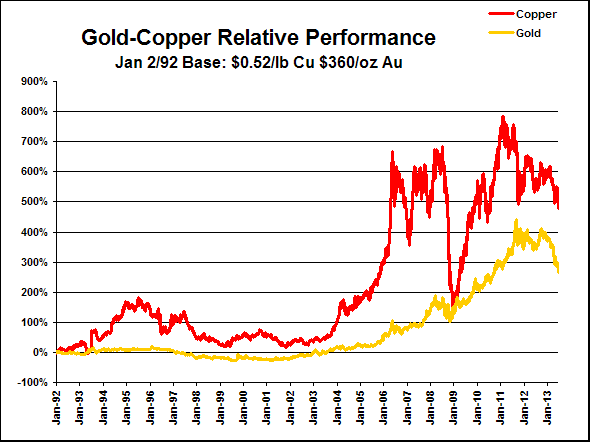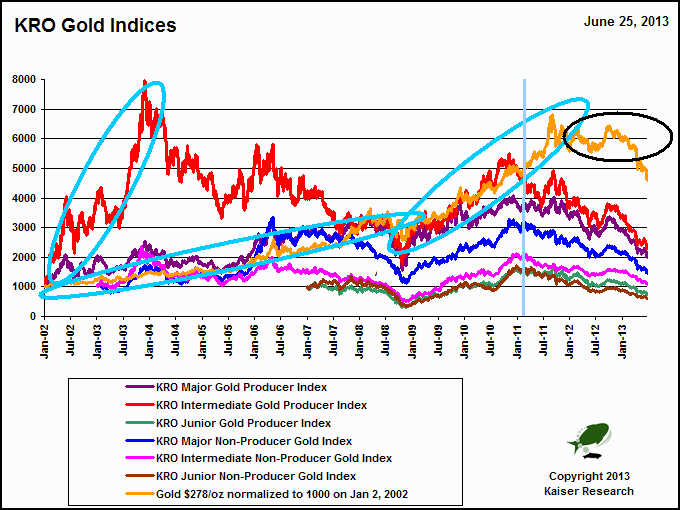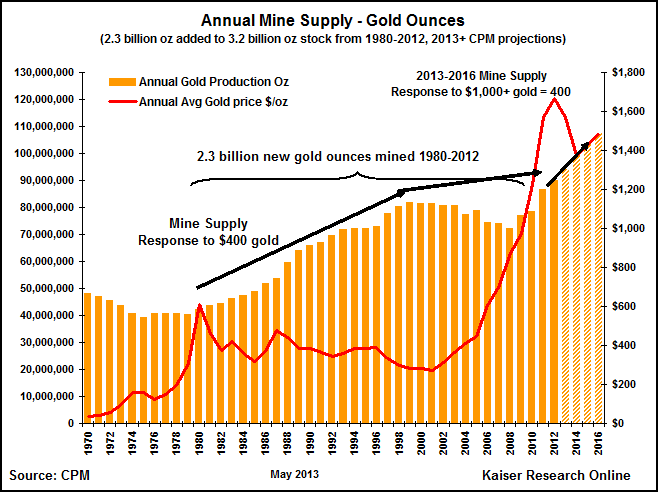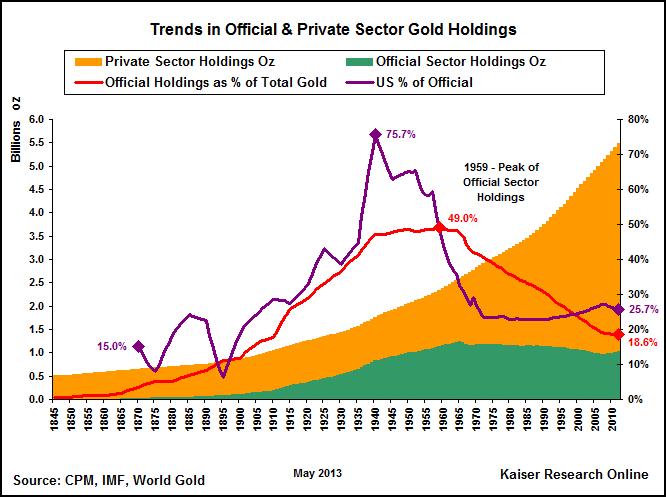Blog June 26, 2013: Big Picture Perspectives needed to assess the Wisdom of Resource Sector Bottom-Fishing
General equity markets have made new highs during 2013, but resource sector companies are plumbing new lows since peaking in Q1 of 2011. The two year resource sector bear market applies equally well to companies developing and mining the raw materials that fuel rising global prosperity, and those focused on precious metals, demand for which is generally believed to reflect fear of declining prosperity. Although most metals remain well above their 2008 crash lows, during the past 12 months prices have retreated 20%-40% from their post crash rebound peaks. Gold in particular is down 36% from the $1,909 record it set on August 23, 2011. With the devastation in resource sector worsening with each downward lurch in metal prices, and valuations approaching the lows of 2008, bottom-fishing has become topical for contrarians. What makes the current situation very interesting is that in 2008 the resource equities were roadkill in a global liquidity trap, while today they have been selectively pummeled by the market. It is a time to bottom-fish, but it has to be done in the context of macroeconomic, geopolitical and psychological assumptions, all of which at best amount to educated guesses.
During the past two years analysts have pondered the disconnect between metal and resource equity prices, and argued that it is only a matter of time before they reconnect, with equity prices rising to reflect what appeared to be stable metal prices. A reconnection is now underway, but not the sort expected. Metal prices have declined this year, unleashing a capitulation sell-off in resource equities that has been especially devastating for the resource juniors engaged in demonstrating the feasibility of existing deposits or exploring for new discoveries. The exodus of institutional capital from the sector has crippled the ability of juniors to fund expensive economic studies on their advanced projects, and an intense risk aversion has sidelined the retail capital that normally funds discovery exploration.

Resource sector bottom-fishing can focus on producers, juniors developing advanced deposits, or juniors exploring to make new discoveries. While there are a handful of juniors producing gold and silver from relatively small mines, production is dominated by intermediate to major mining companies which did very well during the past decade as a super-cycle driven by emerging markets headed by China pushed metal prices to historical highs in nominal terms. Bottom-fishing for producers requires one to make important macro-economic assumptions about global economic growth and metal supply-demand dynamics in the case of raw materials such as copper, iron, nickel, zinc and specialty metals. Because gold has very little economic utility, its demand is not obviously correlated with economic growth. In fact, gold demand is seen as inversely related to copper demand, the world's economic bellwether. However, in the current situation it appears that the price destinies for copper and gold are twinned, reflecting a new reality where demand for gold is a function of global prosperity growth. Whether the target is base or precious metals, the bottom-fisher today must make a prediction about the direction, strength, and timing of future global economic growth.
Resource sector bottom-fishers need to understand the boom-bust nature of the mining industry caused by the 3-6 years required to mobilize new mine supply in response to higher metal prices. Raw material demand rises when the business cycle is in its expansion phase. Because mines typically operate at close to capacity they cannot increase supply to meet the higher demand, with the result that metal prices rise. The mining industry, well aware of its vulnerability to a boom-bust cycle, tends to view metal price rises with suspicion as a short-lived phenomenon. If the economic boom proves longer and stronger than expected, metal prices end up sharply higher, and the mining industry finally acts to expand capacity at existing mines and put undeveloped deposits into production.
Most business cycles are driven by a credit expansion which generates inflationary pressures that central bankers seek to control through monetary policies such as higher interest rates. Inevitably monetary policy creates a downturn in the business cycle which suppresses demand for raw materials just as new mine capacity finally comes on stream. The collision between a supply glut and sagging demand creates a metal price bust that results in heavy losses for the mining industry. Lower cash flow reduces the payback of the capital invested to expand capacity at robust mines. New mines, which usually involve lower grade deposits, may even experience negative cash flow, leading to massive write-offs of invested capital. The market punishes the mining sector, capital for exploration and development disappears, money-losing mines get shut down, and the mining industry resolves that next time the business cycle turns up it will behave differently. And that is precisely why metal prices eventually experience another price boom. In deciding when and what to buy in the resource sector, the bottom-fisher must estimate how long the metal price bust will last, which, of course, requires macro-economic analysis.
The metals bull market of the past decade differed from other post World War II business cycles in that it was driven by political reforms in China that unleashed a hybrid of free market capitalism and central command funding. The emergence of billions of people from a state-controlled economic dead-end as low cost participants in a globalized economy back-stopped by heavy state infrastructure spending scaled up raw material demand far beyond the mining industry's projections. The resulting price boom was characterized as a super-cycle that can run for decades. Once the producers stopped forward selling in 2006 they profited enormously. The juniors also did very well by dusting off deposits discovered in past exploration cycles and discarded as too low grade to develop. Institutional capital attracted by the super-cycle story invested billions helping juniors demonstrate the feasibility of these once marginal deposits. The majors spent over $128 billion during the past decade taking over 225 of these juniors. Very little was actually spent on grassroots exploration, and only a few new discoveries were made.

Unfortunately the super-cycle drew a large part of its fuel from a western credit expansion based on a real estate bubble made possible by a financial engineering innovation called mortgage securitization that dissolved the traditional distrust between lenders and borrowers. The resulting financial crisis in 2008 forced heavy intervention by central banks through money printing policies known as "quantitative easing" to prevent an all out collapse of the global economy. While western economies invoked austerity as a backlash, China embraced old-fashioned fiscal stimulus through a $600 billion infrastructure spending spree that pushed raw material demand out of its 2008-2009 trough to record levels. The mining industry, which had put everything on hold in the wake of the 2008 crash, resumed heavy spending on mobilizing new mine supply to accommodate a super-cycle that was clearly still intact.
China's fiscal gambit was premised on a quicker western economic recovery than the reality created by austerity, the focus on debt reduction as a necessary prelude to a new credit expansion. We have reached a crossroads where Chinese growth has slowed, Europe remains mired in recession, and the American recovery is hostage to a political power struggle where one side sees the resumption of robust growth as the slippery slope for its own defeat. The risk now exists that China may itself implode, ruining western hopes that exploding consumer demand from emerging market populations will eventually tow mature western economies back into a reasonable level of growth, and tipping the global economy into an extended downturn. This potential train wreck for the super-cycle has been on the minds of the market since early 2011 and is one reason resource equity valuations have been in a two year downtrend that has accelerated in 2013. Should this scenario unfold, bottom-fishing for resource equities during 2013 will have been premature.
Concern that the super-cycle has ended and that the future holds lower metal prices has been compounded by another development that has undermined the profitability of new mines. Although general inflation has been modest despite heavy quantitative easing by the United States, costs in the mining sector have annually escalated 4-5 times the general inflation rate during the past five years. Rising capital and operating costs, coupled with tax grabs by governments eyeing metal prices that are nominally high in historical terms, have closed the gap between costs and revenues that opened up during the past decade and which the mining industry has rushed to exploit by mobilizing new mine supply. The shrinking profitability of new mine supply from the cost side is also being exacerbated by a super-cycle inspired glut of supply just as demand growth is weakening, and threatening to go negative. China is a major culprit in this regard, having dramatically expanded the supply of metals with which its large country is naturally well endowed. China as a central command economy that does not need to worry about election cycles does have the ability to convert its surplus into strategic stockpiles, but in western economies where carrying costs are borne by the market the result will be lower metal prices and realized operating losses.
Bottom-fishing in the resource sector now requires the assumption that the American economy, still the largest in the world, will accelerate and thereby underpin a resumption in the growth of global prosperity. But the gridlock in Washington and another debt ceiling crisis looming in September suggests that this assumption is little more than wishful thinking until the outcome of the mid-term elections in 2014 is known. A new credit expansion that drives the American economy will likely not materialize until one of America's two main political parties has conceded defeat. The only wild card that could change the playing field is the arrival of a new common enemy for the United States.
So far the discussion about the resource sector bear market has been about metals in general, but what about the case of gold, a metal that serves little useful purpose in the global economy and thus should not be affected by slowing demand for raw materials? The price of gold has increased more than 600% since its nadir in 2001, and one would think that gold equities producing gold or advancing gold deposits toward production should be experiencing a tremendous bull market. In fact, gold producers, developers and explorers enjoyed their best gains in 2003-2006 before gold surpassed its 1980 peak of $850, but this period did not even come close to the euphoria that engulfed the gold juniors in 1980 when gold stabilized at $400, a level that was 400% higher than $35 in 1972 after adjusting for the high inflation of the seventies. Furthermore, by the time gold peaked at $1,909 in August 2011, gold equities had been in a downtrend for nine months. Despite gold's phenomenal gain, even after retrenching to the current level, the market sense has been that gold's real move, the one that would unleash bubble conditions in the gold equities, was always just around the corner, inhibited by vast government conspiracies designed to hide the true state of affairs. Given that the United States has engaged in unprecedented quantitative easing, and nothing has been done to chill the entitlement expectations of the boomer generation that started retiring in 2010, one has to wonder if the market disconnect between gold equity valuations and the price of gold does not in fact represent an extraordinary bottom-fishing opportunity.

The truth hitting home of late is that in fact there is not much of a disconnect at all between the price of gold and valuations of gold equities. Gold mining has been hit by the same cost escalation as the mining industry in general, and while the current gold price is nominally well above the levels that prevailed during the past 30 years when gold miners added 2.3 billion ounces to the 3.2 billion ounces mined during the 5,000 years prior to 1980, the real cost of mining new gold ounces has risen to such an extent that there is little profit margin to be harvested in mobilizing a meaningful amount of new gold supply at the current gold price. During the 40 years following the repricing of gold from $21 to $35 per oz the mining industry harvested whatever low hanging fruit it could find. The jump to $400 during the seventies brought a whole new range of formerly high hanging golden fruit within reach of the mining industry, helped out by innovations in extraction technology such as heap leaching. The end of the Cold War in 1989 opened up new mining frontiers in Latin America, Africa and Asia where low hanging fruit had been inaccessible. But much of this low hanging fruit has now been harvested, and the steady rise of mining costs has turned what remains back into high hanging fruit, even at current gold prices which are 3-4 times the $400 level that defined profitable gold mines for much of the past three decades.

What is needed is a substantial real increase in the price of gold, driving it past $2,000 without accompanying cost inflation. But that is not what is promised by the dominant narrative among western investors which views gold as a safe haven against extreme phenomena like hyper-inflation and debasement of fiat currencies. Under this view gold has an absolute value expressed in fiat currencies, among which the US dollar is the benchmark, that reflects the intrinsic cost of producing significant new ounces of gold. Fiat currencies are indeed vulnerable to excessive expansion of the money supply, and should this happen, one would expect the currency cost of goods and services to rise. Gold, in contrast to money, would not lose its purchasing power in this sort of inflationary environment, and its dollar price would rise as the purchasing power of the dollar declines. Gold thus serves as a hedge against inflation, provided one ignores the fact that governments such as the United States impose a "collectible" capital gains tax ranging 30%-40% on the dollar value appreciation of gold.
Unfortunately, an increase in the price of gold that merely tracks inflation does not enhance the profitability of mining gold deposits, because the mining cost will also track inflation. The initial disconnect between the prices of gold and gold equities that began in 2011 even as gold surged higher, reflected the market's growing realization that the main reason offered for gold ownership was not going to do much for boosting the profitability of gold mining. When one also took into consideration that the mining sector's costs were increasing at a greater rate than general inflation, and that natural depletion was forcing producers to mine lower grade deposits at those rising costs, the promise of higher gold prices premised on inflation expectations hardly seemed like a good reason to invest in gold equities.
Yet another reason for the early disconnect between gold and gold equity prices was the realization that the "fear" argument for gold ownership would diminish if the American recovery gained traction, an outcome almost everybody desired. Rather than experiencing hyper-inflation and negative real economic growth, the American economy could experience real economic growth that in turn would lead to higher interest rates, cessation of "quantitative easing" and federal deficit reduction. Because gold generates no tangible return other than possible price appreciation, it would be hard to justify gold ownership instead of interest yielding debt related to a vibrant economy. The sharp decline of gold during the first half of 2013 can be partly attributed to "concern" that the American recovery was accelerating. Since robust economic growth is rarely accompanied by deflation, and deemed to be a reason to exit safe havens such as gold in order to participate in the rise of global prosperity, hedge funds with exposure to gold and gold equities suffered heavy redemptions from investors welcoming a booming general equity market and a renewed promise of better times. The resulting capitulation has created rock bottom prices for gold equities justified by the perception that the future held lower gold prices but higher mining costs which implied negative cash flow for operating mines and no reason to develop new mines from anything but new discoveries with exceptional grades.
So what possible reason could one have to justify bottom-fishing for gold equities at this point? Even if you still believe hyper-inflation is just around the corner, the only reason you would buy gold equities is the hope that a sharply rising gold price driven by inflation would trigger a sucker rally in gold equities into which you could sell your bottom-fish positions. There is, however, an alternative narrative that promises a higher real price for gold that would substantially boost the intrinsic value of gold equities. For that narrative we have to look at the emerging markets, in particular Asia, where gold ownership is a function of rising prosperity, unlike Euro-America where gold ownership is treated as a hedge against an apocalyptic future. Asians treat gold as a store of wealth to a far greater extent than westerners, and Asia has the greatest prospect for economic growth going forward, courtesy of globalization and a much larger population base than Europe and North America. Following gold's sharp decline in April caused partly by hedge fund liquidation of ETF gold, demand for physical gold surged around the world.
The obvious question is, if an accelerating American recovery gives new legs to global economic growth, especially within the emerging market economies which export to American demand, and the ensuing prosperity fuels demand for physical gold, of which the mining industry is loathe to mine more of when the gold price is only modestly higher than the real cost of mining new gold, where can the price of gold go other than up in real terms? This alternative "prosperity" based gold narrative promises a higher real price for gold for exactly the reasons that the apocalyptic gold narrative worries that the price of gold would decline. Furthermore, the promised price increase is of a real nature that is beneficial for gold equities. If you believe that prosperity drives gold demand and higher real prices in the current context of a gold depletion cycle coming to an end, then you have good reasons to bottom-fish not just for gold equities, but resource sector equities in general.
This return to global prosperity growth scenario, ironically, also provides a fear based rationale for gold ownership. Although the American economy continues to grow in absolute terms in this optimistic scenario, its share of the global economy is declining, which will over the next 10-15 years destabilize the balance of economic and military power currently dominated by the world's sole super-power, the United States. It is unclear how globalization will fare in such a future, and it is unlikely that the US dollar will remain the world's single reserve currency. It is also unclear how China will behave once its economy has eclipsed the American economy, and its cyber-troops have scooped every American military and technological secret. The transition to a new global order will be messy, with the smaller nations stuck on the sidelines as the bigger nations jostle with each other. Official sector gold ownership has declined since Nixon set gold free from its convertibility into dollars at $35 per oz. A return to official sector accumulation of gold as a hedge against balance of power gyrations could become the top driver for a higher real price.

The private sector currently owns 82% of the above ground gold stock consisting of 5.5 billion ounces, while the official sector owns an all time low share of 18%. The private sector has been busy buying physical gold and stashing it away as that insurance policy you hope never to have to use. Although net central bank gold buying has been modest at 675 tonnes since 2007, there is a distinct skew between net buyers and sellers. The net buyers have been the emerging market economies led by Russia, China, Turkey, India, Saudi Arabia, Mexico, South Korea, Thailand, Philippines, Kazakhstan and Brazil who bought 2,526 tonnes to the end of 2012. The net sellers have been governmental agencies such as the IMF and ECB, geopolitically stressed nations such as Libya and Venezuela, and European countries such as France, Switzerland, Spain, Sweden, Germany and Holland who sold 1,861 tonnes and who play a diminishing role in the future growth of global prosperity. Given the private sector's strong appetite for gold ownership that will only increase if the American recovery accelerates, imagine what the impact on the price of gold would be if the official sector stepped up buying physical gold as a strategy preparing them for the power vacuum that looms in 10-15 years? Such a shift could happen overnight, and represents the best prospect for a sharp uptrend in the price of gold during the next 12 months.

The opposite scenario is that the American economy falls back into recession, China implodes, and Europe's recession turns into a depression. If this outcome became reality, bottom-fishing for resource sector equities during 2013 will prove to have been a bad mistake. If bottom-fishing activity is not accompanied by some measure of anxiety, it is a bad idea. Bottom-fishers who believe that an accelerating American recovery is imminent, that prosperity growth is the real driver of gold demand, and that an American recovery ultimately leads to a relative decline for its current status as the dominant economic and military super-power, should bottom-fish for junior gold equities which own advanced gold deposits for which economic studies are done or underway. Bottom-fishers who think it may be a couple years before the American recovery gains traction should look for resource juniors actively engaged in exploration for new deposits. In the current bear market environment the market is only receptive to results which imply a grade and size that would be very profitable at current metal prices. A discovery only counts as such if the grade exempts the audience from monitoring the price of the metal. The apathy towards advanced projects in the absence of definitive metal price uptrends, and the scarcity of juniors sufficiently funded to conduct discovery oriented exploration, turn new discoveries into magnets for market action that can rapidly deliver 5-10 times price gains from pre-discovery levels. A company's willingness to mount a drill program qualifies as an important selection criterion, because any junior willing to shoot its last bullets at a time when the bullet factory is shuttered, must have a degree of confidence in the target that never registers in times when exploration capital is easily raised. Because of the uncertainty about stronger real metal prices, which creates a timing risk, and uncertainty about which drill target will turn into a new discovery, resource sector bottom-fishers should assemble a portfolio balanced between juniors owning existing deposits and those exploring for new ones, with diversification among metals.